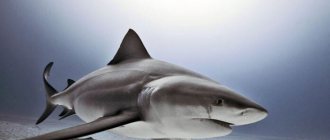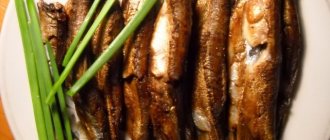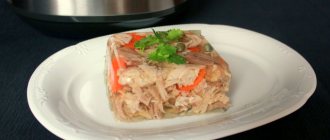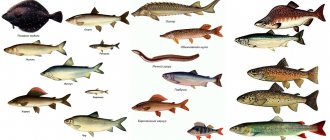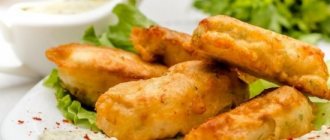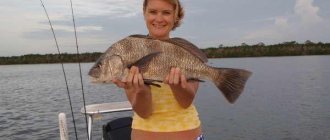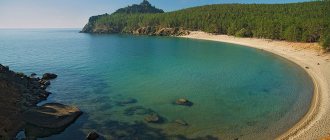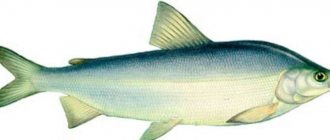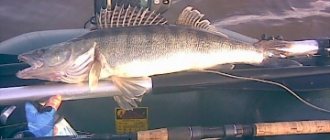Features of fishing on the Kola Peninsula
The Kola Peninsula is a unique place in which unique landscapes, clean reservoirs, mountain lakes and northern coniferous forests are harmoniously intertwined. The main advantage of the region is considered to be the rivers in which salmon spawn. Therefore, fishing on the Kola Peninsula attracts both experienced fishermen who dream of catching trophy salmon, and those for whom this activity is one of the active recreation options.
About the climate of the peninsula
The climatic conditions of the Kola Peninsula are unique and differ from those prevailing in neighboring regions in latitude. In winter, when the Christmas frost comes, the air temperature here drops to -40°C. The rest of the time the mercury column does not cross the -20°C mark. The hottest month is July. During this period, the air warms up to + 13-28°C.
The region's weather is unpredictable, due to the influence of two sea currents - warm and cold. Precipitation is heavy: it often rains in summer and snows in winter.
A significant part of the Kola Peninsula is located beyond the Arctic Circle, so from November to mid-January the polar night prevails here. In the evening, the sky is illuminated by the northern lights, reflected in the snow-white cover of the earth. It is twilight during the daytime.
With the onset of summer, night gives way to an endlessly long day. Bird singing is heard around the clock, forests and fields are covered with flowers, among which juicy berries ripen and fragrant mushrooms grow. The polar day begins on May 23 and lasts until the end of July. In autumn, nature delights the eye with a riot of colors and a variety of shades, and in spring – with lush blossoms and lush greenery.
When does the fishing season start?
Winter fishing tours to the Kola Peninsula begin in November-December, lasting until May. Conventionally divided into three periods:
- ice formation occurs at the end of December - beginning of January;
- spring - from March to the tenth of April;
- on the last ice - from mid-April to early May.
Reservoirs begin to become covered with ice around October. Its strength increases by mid-winter, and in January it becomes so strong that making a hole can be difficult. Ice fishing on rivers ends in May, although complete melting of the ice sometimes occurs only in June.
Who is being caught and what?
Salmon is considered the best fish among experienced fishermen. It is often caught in most reservoirs of the peninsula, and weighs at least 2.5 kg. Part of the salmon catch is usually released after first removing the hook from it. This must be done extremely carefully, as delicate fish are easy to injure. But not only it can be caught in winter. Numerous lakes, reservoirs, and streams scattered across the Kola Peninsula are inhabited by a huge number of fish, which are no less exciting to catch. For example, brown trout, which resemble salmon in habits and strength, is excellent for this purpose. It is believed that anyone who manages to master the wisdom of catching trout will easily cope with other sturgeon.
It is no less interesting to try to catch grayling. Its size can be very impressive. In addition to the named species of fish in the winter reservoirs of the Kola Peninsula you can catch:
For winter fishing use:
- winter fishing rods;
- self-traps (jerks).
- In summer, fish are caught:
- spinning rod with any suitable bait;
- fly fishing rod “waddling”;
- from the boat to the “track” or randomly.
As bait for winter and summer fishing, you should take maggots, dung and earthworms, bloodworms, live bait, jigs, spoons and balancers. The northern summer is short, and the fish are not particularly pampered with food, so it is not difficult to catch them at any time of the year.
Regardless of the presence or absence of ice fishing experience, winter fishing on the Kola Peninsula will be an exciting adventure for both beginners and experienced fishermen. For a more active pastime, you can alternate it with snowmobiling, dog sledding or sledding downhill.
Features of fishing in the Murmansk region
Fishing in the Murmansk region
Fishing on the lakes and rivers of the Murmansk region is carried out both with spinning and fly fishing. In the latter case, you need to have certain skills. But fishing with a spinning rod can give even a beginner a good catch. Experienced fishermen, judging by reviews, catch up to five kilograms of salmon in rivers in the south and central part of the region, and up to fifteen kilograms in northern waters. Sea fishing is also exciting. In the Murmansk region, fish go to spawn in numerous lakes and rivers precisely from the Barents water, where they, in fact, live permanently. Even in winter, due to the warm Gulf Stream, it is warm here, so fishing in the Barents Sea does not stop even at this time of year. Fishermen enjoy fishing for cod, often boasting of a successful catch reaching up to thirty kilograms.
Amateurs catch salmon in rivers in the south and center of the region up to 5 kg, and in northern waters up to 15 kg. Sea fishing in Murmansk is exciting, since fish come to spawn in rivers and lakes from the sea, where they actually live permanently. In winter, due to the warm Gulf Stream, it is warm, so fishing in the Barents Sea does not stop even at this time of year.
Fishing in Murmansk is exciting in its own way. The catch is always rich, prices are reasonable. But, of course, all fishing enthusiasts need to choose suitable and reliable equipment in advance. Fishing in the Murmansk region is available on boats, but visitors must have a passport with them. Everyone can taste the sea air, romance and return home with a decent catch.
Fishing in reservoirs
Real trophy fishing in the Murmansk region on reservoirs. This is where spinners should look for real trophies. But you can also catch big fish there with fly fishing. Pike weighing 10-12 kg is not at all uncommon.
Fishing with surface poppers in shallow, snag-laden bays leaves especially vivid impressions. Pike are especially aggressive here; it happens that while trolling they can grab two wobblers at once. While trolling, large trout are caught. It is caught in deep places of the reservoir using deep wobblers, near the mouth of Katskim. If you happen to attack a school of perch, your arm may ache from the fatigue of dragging them from the water.
Typically, perch and pike in reservoirs are caught near the edges, jig baits or oscillating spoons. The reservoir is a real testing ground where you can test any gear, improve it, look for the most optimal bait options, use various fishing techniques, and the like.
Fishing on the rivers
The region is home to a huge number of large and small waterways. The largest river in the Murmansk region is Ponoy, 426 kilometers long. In the central part of the region and in the south, water arteries have a slight slope. Salmon that weigh from two to four kilograms accumulate here. Northern rivers are shorter. They have steep slopes, rapids and waterfalls. They contain strong and large salmon, weighing from eight to twelve kilograms. Judging by the reviews, in order to catch them, you need to have certain skills and, of course, good and strong gear. For beginners, salmon fishing on the Varzuga River is recommended at the end of May. According to reviews, no one has ever left here without loot.
In the fast, rapids rivers of the Murmansk region, using a spinning rod or fly fishing, you can catch salmon, brown trout and pink salmon, and, if you have a license, the famous twenty-kilogram Atlantic salmon. The waterway of the Kola region is considered one of the most visited for mass fishing. Thousands of amateurs come here every year in hopes of landing a record-breaking salmon. The Kola River is large. It is included in the list of the five largest arteries on the Kola Peninsula. The river has its own characteristics, without knowing about which you can remain without a catch for a long time.
In general, to successfully fish in the Murmansk region you need to have some experience. And first of all, this applies to salmon fishing. In particular, you need to be able to cast to the required distance.
Fishing on lakes
Many fishermen associate fishing on the Kola Peninsula with salmon. It really is one of the most valuable and delicious underwater inhabitants of this region. However, in recent years, salmon fishing in the Murmansk region is allowed only with a license, and in most reservoirs it is sport fishing - on the “catch and release” principle.
However, there are also plenty of other fish here that can be easily fished. And judging by the reviews, fishing on the lakes of the Murmansk region is especially good, including winter fishing. The largest of them are Imandra, Lovozero and Umbozero. The first of them is located in the southwest of the Kola Peninsula. Imandra is literally teeming with different fish. Here you can catch char and whitefish, pike, vendace and, if you're lucky, salmon. You can fish in Imandra both from a boat and from the shore. You can use both a spinning rod and a fishing rod as gear. Among other things, the area around the reservoir is amazingly beautiful. Therefore, local residents come here for the weekend with whole families, pitch a tent on the shore or stay at one of the bases.
It is located in the north of the Murmansk region between the mountains. The water in Umbozero is incredibly clean and turquoise. The lake is incredibly deep. From the cool waters of Umbozer you can easily catch Arctic char and brown trout, pike, salmon, pike and vendace. Since the icing of the lake, winter fishing has been incredibly popular here. In the Murmansk region, in the lakes you can catch char weighing up to three kilograms and trout weighing almost the same. The tributaries of Umbozero are also rich in fish, and the waters of the Umba River flowing from it are full of grayling, which is caught here by fly fishing. This inhabitant of reservoirs sticks to the same places. In summer it can be pulled out on the rifts, but in winter it prefers deep reaches or goes into the lake.
Sea fishing
Sea fishing in the Murmansk region
Fishing in the Barents Sea is considered a real man's activity. The harsh climate of the north and the fresh breath of the Arctic, the uniquely beautiful landscapes and, of course, the rich catch, which is only possible in the clean waters here, leave no one indifferent.
Here you can fish for all species living in the Barents Sea. These are trophy cod, up to fifteen kilograms, haddock and catfish, ruffe, halibut, pollock and flounder, sea bass, Kamchatka crab, etc.
Tours are organized to Teriberka (Murmansk region), Ura-Gubu and Liinakhamari. Fishermen, accompanied by experienced local residents, go out into the Barents Sea on boats and other small vessels. These port villages have all the amenities for those coming from afar. Exciting fishing and a walk along the fjords and bays of the Barents Sea will not leave anyone indifferent. If you wish, you can also rent a spinning rod here.
Sea fish is much richer in nutrients than freshwater fish. In addition, a variety of tactics are used to catch her. Experienced guides will show you the most catchy places. All this will make sea fishing exciting, interesting and exciting. And even a novice fisherman will not be left without a good catch here.
Winter fishing
Those who are attracted by winter fishing also come to the Kola Peninsula. In the Murmansk region, whitefish fishing is very common. There are many suitable places to catch this delicious fish. In the winter season, whitefish are caught using the simplest gear. When going fishing for this underwater inhabitant, you need to take with you not only an ice auger, but also a jig, a winter fishing rod, a hook, a fishing pole and a fish bucket.
Judging by the reviews, whitefish fishing is incomparable to anything else. He actively and very strongly resists. During the winter months, many locals are excellent at catching whitefish at stake. To do this, they take a fishing line with a diameter of 0.16 mm and a length of two and a half meters, on which they place from three to five hooks. One of them needs to be made the end one, and the rest - on four to five centimeter leashes. As a load, fishermen use a bunch of large pellets, which are capable of lowering gear to a depth of up to fifty meters. It is not recommended to use thin hooks: as a rule, they tear the lips of the prey.
To say that fishing in the Murmansk region is good is to say nothing. This is complete extreme and drive: this is exactly how those who have already come here speak about it. There are especially many enthusiastic impressions about sea fishing. Many say that they didn’t even suspect that pulling cod out of the water from a distance of one and a half hundred meters was so exciting and so difficult. Some compare fishing in the Barents Sea with “bourgeois fishing,” for example, for marlin, and note that the harsh conditions of the Kola Peninsula are much more exciting.
Many especially note fishing from the village of Ura-Guba (Murmansk region). Fishing here makes a lasting impression, as it is combined with an excursion to amazingly beautiful places. The tours that you can buy here are relatively inexpensive, and besides, this money is more than compensated by the sensations that a person experiences not only in the process of fishing, but also simply while on the ship and watching dolphins, fur seals, etc.
Are there any prohibitions?
Fishing in rivers that are salmon spawning grounds is only possible with a license. Without them, a fisherman who catches the eye of fisheries inspectors with collected fishing rods will face confiscation of gear and a fine. The most serious punishment is the initiation of a criminal case for illegal catching of red fish.
One of two licenses allows you to fish without fear of fines:
- "Caught and taken away." Applies to any type of fish. This type of license, in comparison with the second, is in less demand.
- Catch and Release sells out quickly. This is due to the fact that salmon is best caught on the peninsula at any time of the year.
Usually most of her catch, usually the largest, is photographed and returned back to the river. The hook from a delicate fish must be removed carefully, holding it in the water by the tail, so as not to injure it. During spawning and hatching of fry, fishing in some reservoirs is suspended.
Fishing on the peninsula
The Kola Peninsula is very popular not only among Russian fishermen, but also among foreign guests. They come here mainly for salmon and grayling; large pike, perch and ide are also considered desirable trophies.
The incredible nature here is perfectly in tune with sport fishing, so every year the peninsula welcomes several thousand guests. Unlike foreigners who are accustomed to the comfort and obtaining licenses for everything and everywhere, our fishermen with great pleasure go to those places where fishing is free and accessible to everyone.
The rules are the same for everyone
The Kola Peninsula stores in its mountain rivers the wealth of the north - salmon. But fishing in them requires a license. There are few rules :
- It is prohibited to fish or simply be with fishing equipment on the river without a license.
- The license cannot be transferred to another person.
- If a license is issued only for catching with the obligatory release of fish back into the river, then only barbless hooks are permissible (the number of fish released is strictly fixed in the license).
- It is prohibited to fish from a moving vessel.
- Upon completion of fishing, you must surrender your license.
It is worth noting that a salmon fishing license is not a cheap pleasure and is not available to everyone. Salmon fishing takes place annually from June 15 to September 15 in the following areas:
- Kanda.
- Belousikha.
- Crow.
- Kuzrek.
- Titovka.
Fishing with a net is also possible, but only in specially designated areas of Kandalaksha Bay. Established time: from the beginning of autumn until the formation of ice.
You can start fishing (and in some cases, simply approach a pond with equipment) only after obtaining permission. All reservoirs of the peninsula are under the constant control of fisheries inspection, and they are patrolled by riot police.
Recreation centers
Local residents recommend the two largest recreation centers: Pana and Efimozero. You can come here with the whole family and enjoy not only promising fishing, but also active recreation in the fresh northern air.
Pana is located on a reservoir of the same name. In the right tributary there is a place for licensed fishing, about 10 km wide. Here the prey can be: pike, grayling, perch.
The recreation center is fully prepared for both the summer and winter seasons of receiving guests. In summer, the fishing tour includes:
- Cottage rent.
- Three meals a day.
- Bathhouse.
- Brazier.
- Catch and release license.
- Watercraft rental.
- Guide services.
In the winter season, travel to the base on snowmobiles has been added to the opportunities provided. They can also be rented for moving around the nearby area.
Efimozero is located in one of the most beautiful places on the Kola Peninsula. Getting here is quite difficult even in the summer season, due to the polar forests and tundra surrounding this place. But it is here that you can truly enjoy the beauty of nature, almost untouched by man.
The base staff assists in all matters, starting with the preparation or rental of equipment necessary for fishing. Accommodation here is possible in two houses for 5 and 6 guests. The houses are equipped as follows:
- Electricity.
- Gas stove in the kitchen.
- Heating is stove.
- Bathhouse.
The abundance of fish such as pike, perch, whitefish and grayling will not leave anyone indifferent.
About fishing tours to the Job Reservoir
We offer you a seven-day fishing tour to the Job Reservoir.
The cost of fishing tours on the Kola Peninsula includes:
- payment for food;
- instructor services;
- organization of a tourist bath;
- rental of equipment for setting up a camp, fishing and recreation;
- transfer;
- rafting;
- rental of equipment used for rafting.
Prices depend on the duration of the tour, the number of people in the group, and additional services provided at the request of the group.
Additional services are:
- rental of sleeping bags;
- tents;
- payment of railway tickets;
- health insurance.
A standard group consists of 8-15 people, but it is possible to organize a tour for a group of a maximum of four fishermen. The duration of the individual tour and the period in which it will be held are discussed separately with the managers.
Fishing and relaxation on the Kola Peninsula is a wonderful pastime, during which you will enjoy unforgettable landscapes and taste fish soup from the fish you just caught. In winter, you can admire the northern lights and simply take a break from everyday worries, and in summer, enjoy mushrooms and berries.
The tourist bath provided by the tour program will relieve travel fatigue, relax strained muscles and relieve tension. An overnight stay in the field and fishing will give you a lot of positive emotions, make you forget about problems, distract you from negative thoughts and, perhaps, push you to new achievements.
Fishing on the Kola Peninsula
Kola Peninsula... A treasured region for keen fishermen. The land of thousands of rivers and lakes populated with coveted trophies for many fishermen. The land of harsh northern beauty, the sun shining in the middle of the night and snow-capped mountain peaks.
At the beginning of the short northern summer, when there is still snow along the banks of the rivers and some lakes are still frozen, enthusiastic fishermen flock here from all over the globe in search of a meeting with the treasured queen of the northern rivers - salmon. Here are the world-famous salmon rivers - Yokanga, Kharlovka, Rynda, Vostochnaya Litsa, Varzina, Ponoi... At the end of spring and beginning of the calendar summer, incredibly strong, colorful silver-colored Atlantic salmon - salmon - rushes into the rivers. This time, the time of high water in the rivers and fresh fish, only from the sea, is the best to try your hand at a duel with large and strong fish. This is the time of real trophies, warming for a long time with memories of crystal clear rivers and powerful jerks of fish that keep your nerves and gear on edge.
In addition to the rivers listed, there are dozens of rivers on the Kola Peninsula where salmon also come and where you can try your hand at catching the coveted trophy. Some rivers can be reached by car, while others can only be reached by all-terrain vehicle or helicopter. Somewhere along the shores there are comfortable fishing bases where you will be served at the highest level. Somewhere you can fish on your own in a tent camp. Here everyone can find an affordable and suitable option for themselves. Moreover, you can catch salmon throughout the entire calendar summer, depending on the area of the peninsula where you are going.
But the Kola Peninsula is famous not only for its salmon. The leopard of northern rivers and lakes, the brown trout, also lives here. An incredibly beautiful and powerful fish, mesmerizing with its violence during fishing and many variants of spotted colors. There are cases when a brown trout spends almost half of its fishing time in the air, making cascade after cascade of amazing jumps - “candles”. Large trout are a very worthy opponent, in no way inferior to salmon in terms of strength and tirelessness. Several forms of brown trout live on the peninsula. Marine - feeding in the coastal parts of the White and Barents Seas and entering rivers to spawn. Sea trout are distinguished by their silver-spotted, blue-tinged color. On many rivers salmon are excellently caught in the mouths during high tides. And it is often found in rivers when fishing for salmon. Lake-river trout - brown trout living in large deep lakes and reservoirs of the peninsula. It also has a silvery color and a very powerful, well-built body structure. The largest form of brown trout. Trolling is common in lakes. But the most sporting fishing, of course, occurs in rivers where brown trout from lakes and reservoirs rise to spawn. Lake trout can also be found in many lakes and lambins scattered across the endless tundra of the northern part of the peninsula. Here it amazes with its variety of colors - even in one small fish tank you can find fish of completely different colors. Brook trout - lives in many small rivers and streams throughout the peninsula. Despite its small size, brook trout are a great pleasure to catch when fishing with light and ultra-light tackle.
Also, along with brown trout, in tundra lakes you can often find another very beautiful and lively fish - char. Char under these conditions rarely grows to a large size, but even a one-kilogram fish can bring a lot of pleasure from fishing with light tackle.
There are many options for catching large trout and char. There are also high-class fishing bases, with helicopter delivery, to the most distant and wild areas of the peninsula. Where trophy specimens of brown trout live in large numbers. Recently, multi-day hiking trips to the tundra, offline, have become very popular. But here, of course, it is better to use the services of fishing guides.
Also, once every two years, pink salmon enter the rivers of the White and Barents Seas to spawn. This fish was acclimatized several decades ago and has successfully taken root here. Although pink salmon is not distinguished by its large size, in terms of the sportiness of catching it, especially fresh fish from the sea, it is in no way inferior to either brown trout or salmon of the same size. Especially when fishing with light class gear.
In addition to these famous salmon fish on the peninsula, in many rivers and lakes, you can find lively grayling and whitefish, which in northern latitudes reach decent sizes and have predatory habits. And of course pike and perch. These fish, familiar to any angler, live in most lakes and reservoirs on the peninsula. Where they often reach impressive trophy sizes and show remarkable strength and perseverance during fishing.
In winter, the peninsula is covered with snow for a long time and lakes and rivers are covered with a strong, impressive layer of ice. But fishing continues at this time. Exciting ice trolling for brown trout and char is the most sporting and interesting type of ice fishing. Requiring good knowledge of the topography of reservoirs, perseverance and fishing luck. Often it is in winter that the largest specimens of char are caught. In summer, it hides in the depths of large lakes, and it is not so easy to wait for its bite, even with modern trolling equipment. In winter it is much easier to get close to it and catch a real trophy.
Winter flashing of pike and perch. Active active fishing for grayling and whitefish on river reaches and pits. Exotic, for fishermen of the central regions, smelt fishing. The ice fishing season lasts from November to May, and is the longest on the peninsula.
In addition to lake and river fishing, the peninsula is famous for vertical sea fishing for large cod, haddock, pollock, sea bass and, of course, halibut. From early spring, as soon as winter storms end and daylight hours become longer, boats and boats set sail from the coast of the Barents Sea in search of deep-seated trophies. The sea fishing season lasts from March to November, but the best time is the first months of spring and autumn.
And this is only a small part of what can be told about the wonderful fishing region - the Kola Peninsula. To experience all the beauty and charm of fishing here you have to be there yourself. After all, after the first trophies and views of the northern beauties, you will come back here again and again...
Fishes of the Kola Peninsula
Use the “Catch and Release” principle!
“Game fish are too valuable to be caught only once.” — Lee Fulf, famous American fly fisherman, 1939.
This is what Atlantic salmon looks like, salmon (lat. Salmo Salar) that has just entered the river from the sea. The most valuable commercial fish. Catch strictly according to issued licenses. At this stage it has exceptional gastronomic qualities. Specimens up to 30 kg in size enter the rivers of the Kola Peninsula.
This is what salmon look like when they have spent some time in a river or lake and are ripe for spawning. (Male above, female below). If the fish came in in May-June, then it acquires this color by August. At this stage, the salmon is “in fighting shape” and catching it is a thrill. Taste qualities sharply decrease after the marine form. It is recommended to release such fish into the river.
This is what salmon look like (male above, female below) having already entered the spawning stage, usually in September-October, they are about to lay eggs or are already guarding the hatching larvae in the nest. Such fish must be released without injuring them.
This is what salmon (kelt, valchak) looks like in the spring, but after the autumn spawning. This fish is trying to get back into the sea to recover from exhaustion. To confiscate such a fish, which has actually conquered all stages of river obstacles, is simply moral blasphemy.
Illustration by Paul Vecsei
A young salmon lives in the river for several years. Outwardly, it resembles the brook vorelle, but differs from the latter in the presence of vertical blue spots. If accidentally caught, it should be immediately released into the wild. The state pays a lot of money for the artificial cultivation of salmon.
Illustration: Linda Nyman
Brown trout. The female is at the top, the male is at the bottom.
Illustration: Linda Nyman
Sea trout (sea trout).
Illustration by Paul Vecsei
Brook trout.
Brown trout, brook trout, sea trout fish of the same species Brown Trout (lat. Salmo Trutta). Typically, local residents call trout fish up to 1 kg that live in streams and lakes. Specimens larger than 1 kg are called brown trout. Brown trout living in the sea or deep clear lake wear a silver outfit, and fish living in a lake or river with peaty water are brown. They have residential, walk-through and semi-pass-through forms. Sometimes these species live together in the same body of water. Reaches a size of 15 kg. According to the rules of amateur fishing, specimens over 40 cm long (from 1 kg) are suitable for seizure.
Source: www.atlanticsalmontrust.org
Difference between Atlantic salmon and sea trout. I - Atlantic salmon, II - sea trout. Salmon differs from large sea trout in having a more streamlined shape, a concave tail, a thinner tail wrist, and a short upper jaw (no longer than the back of the eye). Salmon have almost no spots below the lateral line. Salmon have 10-15 (usually 11-13) rows of scales between the adipose fin and the lateral line; trout have 13-16.
Grayling (lat. Thymallus thymallus). Inhabits many rivers of the Kola Peninsula. The most delicate fish. Requires careful handling. When catching a small specimen, you should remove the hook from the mouth without removing the fish from the water. Grows up to 3 kg.
Illustration: Tim Knepp Pink salmon (lat. Oncorhynchus gorbuscha). As a result of an unsuccessful acclimatization experiment, this Far Eastern fish is seriously competing with Atlantic salmon on spawning grounds. In recent years, it has become a trash fish and is recommended for mandatory removal when caught. Kola pink salmon meat has low culinary appeal compared to salmon. Grows up to 5 kg.
Illustration: Linda Nyman
Arctic char (lat. Salvelinus alpinus), listed in the Red Book. In different habitats of the Kola, these fish have a wide variety of colors, reminiscent of the variegation of trout. It has a pass-through and semi-pass-through shape. If caught, it should be released into the wild.
Illustration by Paul Vecsei
Lake char, palia (lat. Salvelinus lepechini). The fish is rarely found in the lakes of the Kola Peninsula. Listed in the Red Book. It grows in large lakes up to 15 kg, but there is a dwarf form up to 900 grams.
Illustration by Paul Vecsei
Whitefish (lat. Coregonus). Found in the sea, lakes and rivers of the Kola Peninsula. The meat is tender and tasty. Grows up to 5 kg.
Burbot (lat. Lota lota). Contrary to all claims, burbot is a northern fish. On the Kola Peninsula it grows up to 10 kg in size.
Illustration: Linda Nyman Common minnow (lat. Phoxinus phoxinus). The smallest freshwater fish of the Kola Peninsula.
Of the fish familiar to the Middle Zone, we can mention perch and pike, which are found in abundance on the Kola. Roach and ide are found in some lakes. To be completely honest, we should also indicate the carp and sturgeon that live only in one place on the Kola Peninsula - this is the confluence of the Kola Nuclear Power Plant canal into Lake Imandra.
TOP
Fishing on the Kola Peninsula
Russian North. Majestic, wild, and pristine. The untouched kingdom of Atlantic salmon, the famous Russian salmon, has been preserved here. World famous salmon rivers flow here - the Umba, Varzuga, Strelna, Vyala, Kola, Pana, Ponoi and many, many others.
Fishing on the Kola Peninsula attracts fishing enthusiasts not only in our country, but also in Europe, America, and Asia. Spinning and fly fishermen flock to the rivers of the Kola Peninsula for salmon, large brown trout, and fast-moving grayling. Trophy pike, large perch, ide, brown trout and grayling are caught on the lakes.
If you want to enjoy a unique combination of wild pristine nature and truly sporting wild salmon fishing, we invite you to go fishing on the Kola Peninsula.
And believe me, you will not regret this trip!
The North will not leave anyone indifferent! Fishing on the Kola Peninsula will forever win the hearts of all those who are lucky enough to visit these places.
We offer you several of the most interesting routes along the rivers and lakes of the Kola Peninsula. Our partners - fishing bases on the Kola Peninsula will provide you with high comfort and quality service, organize unforgettable fishing and travel!
Fishing and hunting base
The Tipanovka fishing and hunting base is located on the northern coast of the Kola Peninsula (see map) near the mouth of the Tipanovka River. The distance from the fishing and hunting base to the river is about 100m. The river flows into the Barents Sea, the distance from the fishing and hunting base to the sea is 700m*.
The convenient location of the base (2.4 nautical miles to Maly Oleniy Island and 6.8 nautical miles to Kildin Island) and direct access to the sea provide an excellent opportunity for sea fishing: there is no need to go very far in search of fish, all the cool places are from Kildin Island Cape Teribersky is within walking distance. Also along this route, starting from the west, is the migration of the “minnow” cod. And on the Tipanovka River you have the opportunity to catch Atlantic salmon (salmon) with permitted gear within the time limits established by law.
The living conditions and the atmosphere that prevails at our base will pleasantly surprise you: this small island of civilization, absolutely autonomous, using alternative energy sources, lost in the mountain tundra of the northern coast of the Kola Peninsula, will not leave you indifferent. With us you will feel better than at home: just the view of the waterfall from the windows of the house will remain in your memory long after you leave the base, and you will always have a desire to come back here again. Modern technical equipment in combination with stained wood, eaten away by sea bugs, which is used in decoration, gives a special brutal flavor. For those who want to climb into virgin places and at the same time not feel discriminated against in everyday life and enjoy the benefits of civilization, our base opens its doors.
You are welcome to come on board!
Exact coordinates of the base: 69° 14′ 53"N 34° 33′ 29"E
The nearest settlement is the village of Teriberka.
The distance from the fishing and hunting base to the village of Teriberka by sea is 16 nautical miles (30 km), approximately 1.5-3 hours on a motor yacht, depending on weather conditions.
For those who are planning to come to us in winter by snowmobile, it is most convenient to go from 49 km. Murmansk-Teriberka roads. The path (truck) for GPS navigators lies here.
Operating mode
The base is open all year round. You can come to us for a couple of days, a week, or a longer time. Here you can simply relax, go fishing in the river or in the sea, or go hunting.
Special conditions (discounts, bonuses) are provided to those who reached our base on their own (by snowmobile, boat, skis, on foot, by helicopter, etc.)
Accommodations
8-bed heated wooden house (all year round)
- Two rooms for 3 and one room for 2 people
- Sleeping places are single beds. Bed linen, towels
- TV, DVD
- Electricity
- Shower, toilet (toilet)
- Sauna
Adequate meals are provided at the fishing and hunting base.
MTS mobile communications work on the territory of the base (not stable) and on the hill (distance about 300m), Megafon and MTS.
Additionally, walkie-talkies may be provided to the group.
Transport connection
The message is carried out along the route:
Murmansk (station) / Murmashi (airport) - Teriberka village - Tipanovka fishing and hunting base
From Murmansk/Murmashi to the village of Teriberka there is a car (approximate travel time 3 hours), from the village of Teriberka to the mouth of the Tipanovka River - a motor yacht or motor boat (approximate travel time 1.5-3 hours depending on weather conditions).
In addition, you can get to the fishing and hunting base by helicopter (travel time is 1 hour) or by snowmobile in winter from 49 km. Murmansk-Teriberka road 2 hours.
Trophies
- Fish: Atlantic salmon (salmon), brown trout, char, pink salmon, trout, cod, haddock, halibut, catfish, flounder, ruffed flounder.
- Bird: goose, ducks, waders, arctic partridges.
- Animals: white hare, fox, brown bear.
Note
*There are two landing sites from the sea to the base, a distance of 700 meters and 2100 meters. The choice of location is determined depending on the state of the sea: if the sea is calm, then the landing is made in the nearest bay; if it is stormy, then in the far one, because it is more closed and secure. When landing in a distant bay, on the way to the base we additionally cross the Tipanovka River by boat. Please, when collecting your luggage, keep in mind that there are no roads from both bays to the base, only deer trails; tour participants deliver their belongings from the seashore to the base area on an all-terrain vehicle; tourists in the non-tour program deliver their luggage BY INDEPENDENTLY or for a fee.
